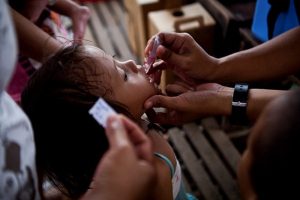One month on
Providing essential health services in areas devastated by Typhoon Haiyan

More than a month on from Typhoon Haiyan, Alberta Hijanda, 55, is living under a tarpaulin with 12 other family members.
“We don’t have any choice,” she told IRIN “We desperately need help.”
Help is on its way. Yet the scale of the destruction means that the response will continue for months to come. The National Disaster Risk Reduction and Management Council’s latest report puts the death toll at almost 6,000, and 1,700 people – mothers, fathers, grandparents, children, sisters and brothers – are still missing. More than a million homes have been damaged or destroyed, and four million people, like Alberta, are displaced.
Whether exposed to the elements or crowded together in evacuation centres, those displaced are vulnerable to communicable diseases – diseases like polio. And with 117 health facilities crippled by the Category-5 storm, the impact of such an outbreak could be devastating.
That’s why the United Nations Office for the Coordination of Humanitarian Affairs lists the “re-establishment of routine services… especially regarding routine vaccination programmes” as a top priority. In the meantime, the Government of the Philippines is working with the World Health Organization, UNICEF and other partners to vaccinate children in some of the worst-affected areas against measles and polio, with vitamin A supplements also given to help improve general immunity.
The campaign, which began in Tacloban in November, is expected to reach over 30,000 children. Fixed vaccination sites have been set up in evacuation centres, while mobile health teams are travelling out into communities.
“The children of Tacloban need all the protection they can get right now,” said Angela Kearney, UNICEF Coordinator for the Emergency Response in Tacloban at the time of the campaign’s launch. “Disease is a silent predator, but we know how to prevent it and we will do everything that we can.”
“WHO and UNICEF staff hand-carried supplies from Manila to Tacloban, coordinated teams to give the vaccines and trained them on how to do it under these difficult circumstances. It is virtually unprecedented that within two and a half weeks of a disaster of this scale, with this level of devastation and these logistical challenges, that a mass vaccination campaign is already rolling out,” says Dr. Julie Hall, WHO Representative in the Philippines.
UNICEF and WHO are helping to re-establish the broken cold chain, which is critical in keeping vaccines at the right temperature, and children are being screened for malnutrition and referred for treatment.












